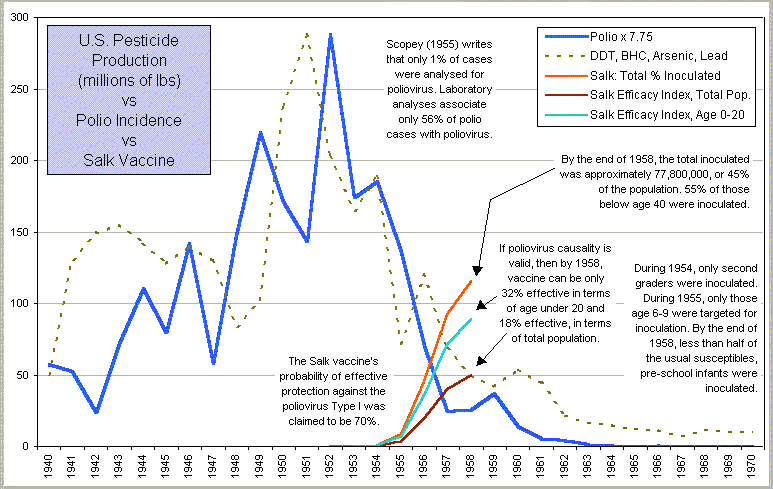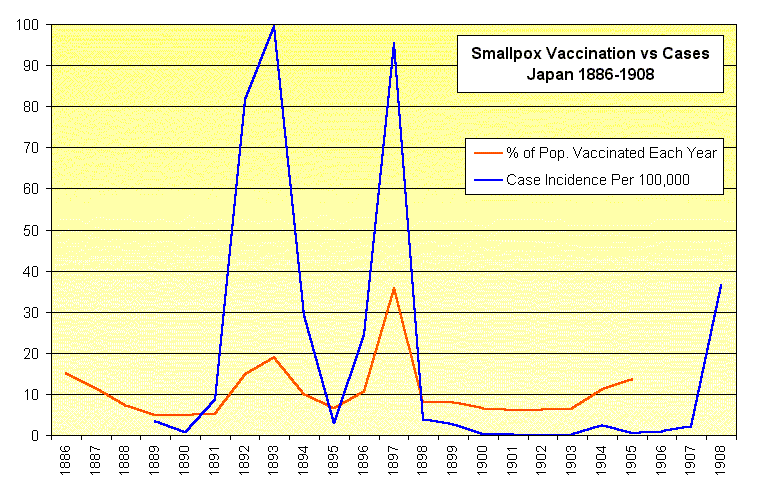The Salk Vaccine
The success of the polio vaccines, like poliovirus causation, is "proved" through interpretations of animal laboratory experiments, and are thus subject to the same criticism as the animal experiments for virus causation, i.e., animal experiments are extremely harsh and thus are unrelated to the human polio disease condition.
Vaccination success in humans has also been "proved" through statistics (epidemiology) gathered from hospitals which show polio incidence declining as vaccination programs are implemented.
"Polio and the Salk Vaccine" is one of the most highly promoted medical images, a typical example:
...the epidemics grew steadily worse each year, with the number of new cases climbing from 5,000 in 1933 to 59,000 in 1952. Salvation came in 1954 with the Salk vaccine...
"A Paralyzing Fear: The Story of Polio in America"
The New York Times, March 4, 1999 (Film Review)
The story of the Salk Polio Vaccine is highly touted by teachers, medical representatives, and in popular, educational, and news/medical media.
Salk Vaccine Timeline, U.S.
1952, Jonas Salk discovered his vaccine, though the technology was not new, being based on vaccines utilized at least by the early 1930s.
March 26, 1953, the Salk vaccine announced, after evaluation of 600 vaccinated persons. (Jane Smith, Patenting The Sun)
1954, during the large field trial, 423,000 second-grade children were vaccinated (T. Francis, from Nathanson, Field's Virology). At the height of the great polio epidemic, children of age 6-9 had become a primary susceptible group and this is said to be the reason that second grade children were chosen. The high susceptibility of infants below age 5 to toxic chemicals (formaldehyde and merthiolate were used in the Salk vaccine) in addition to the harsh method of receiving virus particles by injection, could have been another reason to chose age 7, for age 7 is at the end of the range of infant nerve system vulnerability due to a rapidly growth and myelination.
Nearing the height of the epidemic, the susceptibles range extended from pre-school children to include the age 6-9 and beyond. This is clearly a function of the extreme nature of the epidemic (in terms of the toxic theory). This extension occurred before the height and after the height. Regardless, infants below the age of 5 always were a primary susceptible group.
The primary susceptible group of pre-school children (infants) was not targeted for vaccination against infantile paralysis in 1954 or 1955.
Beddow, p8, writes that within two hours of release of the Francis Report on April 12, 1955, the vaccine was licensed. JAMA, vol 158, no 14, p1249 reports April 12, 1955. However, A Paralyzing Fear, Seavey, 1977, states that the Salk vaccine was licensed by HEW in March, 1955. Seavey is apparently incorrect.
Large scale vaccination begins April 12, 1955. The target age group is 6-9 years (Scheele, A.S., Shannon, J.A., "Health Implications In A Program Of Vaccination Against Poliomyelitis", JAMA, August 6, 1955).
The Cutter Laboratory disaster is discovered 13 days later, April 25, 1955. Documented cases caused by the Cutter vaccine were 79. The EIS went on to find 204 polio cases with 11 deaths out of the approximately 423,000 persons inoculated with Cutter's Salk vaccine (Jane Smith, Patenting The Sun, 1990). Contagion patterns are very difficult to discover with polio, yet the EIS expanded the original 79 cases to 204 by assuming contagion patterns. Tremendous publicity was given to these cases.
April 27, 1955, Surgeon General calls Cutter for a recall of its vaccines (Jane Smith, Op. Cit.).
May 8, 1955, the entire U.S. vaccination program was cancelled by the Surgeon General (Christopher J. Rutty, Dept. History, U. of Toronto, URL:http://www.eskimo.com/~dempt/salk.htm). The program was soon resumed and 5,394,000 persons were vaccinated during 1955.
During 1956, approximately 25,000,000 persons were vaccinated. The 1959 CDC Polio Packet indicates only the cc's of vaccine shipped per month, not persons vaccinated. However, it gives enough information so that the persons vaccinated can be interpolated from these shipment figures.
1956, the federal government rigorously tested the vaccine, and began to take over NFIP's role.
1957, the vaccination program resumed under CDC/EIS control and was highly promoted (Jane Smith, Op. Cit.). Approximately 31,300,000 persons were vaccinated in U.S. (CDC, Polio Packet, 1959)
1958, approximately 15,700,000 persons were vaccinated.
As of 1959, less than half of the usual primary susceptible group (infants below age 5) were vaccinated. Only 55% of those below age 40 were vaccinated, according to the CDC's Polio Packet. 28% of the vaccinations had been given to non-susceptibles, the group of 40 and above.
However...
Polio incidence began its sharp plummet in 1952. This is 3 years before the vaccine was licensed by HEW in 1955. Thus, the Salk polio vaccination did not significantly correlate with declining polio incidence. However, a significant correlation with declining polio incidence is found with reports in 1952 that nursing cow calves were dying with of symptoms and physiology when their mother's were fed fodder that had been treated with DDT.
The plummet also correlates with the 1951 government/industry debate over pesticide safety.
The plummet also correlates with the phase-out of persistent pesticides production in the early 1950s. ("Persistent" pesticides are those which do not easily biodegrade, such as DDT, BHC, arsenic compounds, and lead compounds.)
Dr. Thomas Francis did not mention in his key evaluation of the 1954 Salk field trials that those who contracted polio after their first inoculation and before their second inoculation were placed in the "not-inoculated" list.' (Maurice B. Bayly, The Story Of The Salk Anti-poliomyelitis Vaccine, 1956). During the 1954 field trials second graders only were inoculated, and 1st and 3rd graders used as controls, yet susceptibility to polio (or toxicity) can be highly variable between the ages of 6 to 7 to 8, and as such, this made proof of success difficult.
During the 1954 field trials only volunteers were inoculated, yet the control groups included non-volunteers. This enters even more complex variables into the trial. (Beddow, p14)
Jonas Salk worked for Francis in his laboratory. Francis was a former Army epidemiologist who was involved in U.S. studies of Nagasaki and Hiroshima after the nuclear bombardment. Those studies have been characterized as inaccurate:
...the National Academy of Science... released a new report... the 'BEIR V' report, concludes that cancer and leukemia risks for the survivors... has been underestimated by a factor of three to four, due to faulty dose estimates and insufficient follow-up study of the survivors."
...the BEIR report suggests... legitimate questions about the validity of the currently accepted estimates. (Jay Gould et al, Deadly Deceit: Low-Level Radiation, High-Level Cover-up (1991), p179)
Though vaccination safety was said to be a matter of record, the weekly polio case rates during 1955 show a definite rise in polio case rates during the period of vaccination (April and May), unlike previous or subsequent years. This is not discussed, however, downward movements in the age 7 group (in the age distribution graphs) were used by the CDC to show evidence of vaccination efficacy (CDC, Polio Packet, 1959).
The Detroit Epidemic, 1958
In 1958, laboratory analyses of the epidemics in New Jersey and Detroit associated poliovirus with only 56% of diagnosed cases. The Detroit analysis associated only 51% of diagnosed polio with poliovirus.
Regardless of these associations, a positive finding for the poliovirus would not by itself prove poliovirus causation because this virus is often found during epidemics in those who have no disease symptoms or in those who have disease symptoms that can be attributed to other microbes (Scobey, "Is Human Poliomyelitis Caused By An Endogenous Virus?", Science, v71, 1954).
Detroit
Epidemic, Microbe Analysis
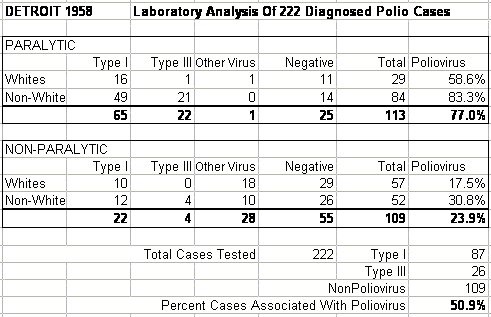
47% of the diagnosed polio cases in the Detroit epidemic were found to have been inoculated at least once, 34% at least twice, 22% at least thrice. Non-white cases had been found vaccinated 54% as much as white cases, however, according to the CDC's Polio Packet, non-white to white paralytic case incidence was 18 to 1, or 1800%:
The epidemic was the second worst in Detroit history. Paralytic cases were 18 times more frequent among non-whites... (Sect. VII, p17, 1959)
A check on these calculations shows the incidence ratio of non-whites to whites actually to be just over 13 to 1, which is intriguing enough. The base numbers are as follows. For those who would like to check for themselves, the non-white to white paralytic cases were 246 to 66. Non-white to white population was 420,000 to 1,480,000). The result, an incidence ratio of 13 to 1, has been applied to the considerations below, which gives a break to orthodoxy. At the time the Polio Packet was published, during the epidemic, the "18 times more frequent" phrase enhanced the imperative for vaccination, since these non-whites were lagging in their vaccination status.
The poliovirus now appears to be unreasonably selective for non-whites. There are many mitigating factors that could be brought to argue against these general impressions. Thus it is necessary to proceed into detailed comparisons.
Age Group 5-9: White vs Non-White
Consider a comparison of the most similar age group, e.g., school children in the age group 5-9. These children were similar in education level, age, and vaccination status. Only the paralytic cases are utilized in this comparison because they were much more frequently associated with poliovirus: 77% of the paralytic cases were associated with poliovirus, yet only 24% of the non-paralytic cases were associated with the poliovirus.
In the 1950s, clinical doctors diagnosed polio according to symptoms and physiological evidence. Only a small percent of total cases in the U.S. were analyzed in the laboratory for presence of the poliovirus. If the poliovirus could not be associated with a case then it was set aside as non-polio. Suddenly, much of the disease called polio was technically not polio. How is that so much non-poliovirus polio rose and declined concurrently with poliovirus polio during the Great Epidemic? No vaccine existed for non-poliovirus polio.
Without pursuing that quackmire, we continue here within the slippery orthodox definitions of polio and limit our focus to paralytic polio in order to deal within a set of cases which can at least be assumed to be mostly poliovirus caused -- just in order to be able to argue the shifting orthodox assumptions.
Regarding the comparison of non-white vs white age group 5-9, we first find that the non-white to white paralytic case ratio is 3.2 to 1. Converted to incidence, which accounts for population differences, we have an incidence ratio of 11.3 to 1.
This vast disparity cannot be explained by vaccination status because these were quite similar. Non-whites were found to be vaccinated 88% as much as whites. Based on this, if polio vaccination was valid, we would expect an incidence ratio between the two groups to be closer to 1.1 to 1, than 11.3 to 1.
The vaccination profile of these cases is provided in the following table:
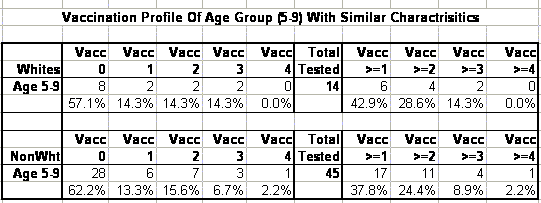
Age Group 0-4: White vs Non-White
The second comparison group is pre-school children in the age group 0-4. These polio cases are, at the least, similar in age, and not very dissimilar in vaccination status. Another similarity is that they both represent the traditionally highest susceptible age group, from whence comes the name "Infantile Paralysis".
The non-white to white case ratio is very different, 6.3 to 1. Converted to incidence, using demographics for this era, an even more stunning incidence ratio is found, 22.4 to 1. This is close to the CDC statement for Detroit, "Paralytic cases were 18 times more frequent among non-whites...". (Polio Packet 1959, p VII, 1)
Yet, this study finds non-whites vaccinated 0.58 as much as whites.
If vaccination was a valid concept then the expected incidence ratio should be closer to 1.7 to 1 than 22.4 to 1. A coefficient of logical disparity would then be 22.4x0.48, that is, 12.99. CDC should have explained this disparity, or refocused their study towards Detroit's environmental hazards and non-white neighborhoods.
The vaccination profile of the 0-4 cases is provided in the following table. Note that the Vaccination Ratio is found by taking the cumulative vaccination count for non-whites (see chart) and dividing that by the cumulative vaccination count for whites, that is, 34.6%.
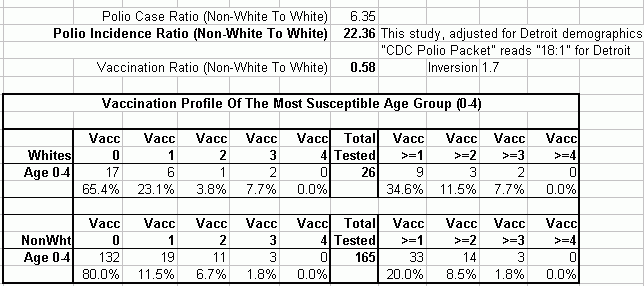
Poliovirus theory creates massive contradictions between public images, epidemiological data, and laboratory data.
The toxic theory can easily resolve these contradictions.
For instance, with regards to the Detroit epidemic a study might begin with a focus upon the industrial pollution of drinking water, extraction solvents in cooking oils, and pesticides in cooking oils (particularly those, which in fine print show their ingredients to include cottonseed oil). Pesticides and herbicides in fatty meat and dairy products should also be analyzed for toxic chemicals. The polio victims should be studied for levels of industrial toxins in their urine, tissue, and in nursing mothers, breast milk. The Polio Packet shows the epidemic peaks in Detroit occurring somewhat later for non-whites, which is consistent with the later harvest time of the cotton crop vs other crops. A similar epidemic shift occurred in a white community in Massachusetts in 1908, where an epidemic centered around three cotton mills.
It is unlikely, in my opinion, but if dietary and toxicology studies were found negative, then a bacterial hunt could begin. If that proved negative, then viropathologists could possibly find rogue, nucleic acid as the culprit. And lastly, if all else fails, it could be asserted that the polio epidemic was caused by genetic defects in the population, with packaged salvation available from biotech industry's nearest representative.
Pesticides vs Polio vs Salk
In essence, the Salk Vaccination program appears irrelevant to the Great Polio Epidemic, as shown in the following graph which represents vaccination data from the above timeline.
